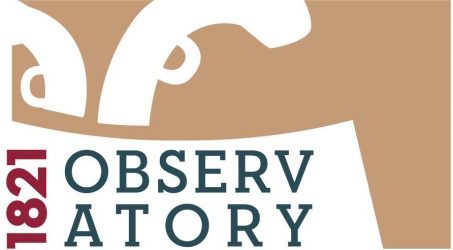Significations of national space
Techniques of memorialisation have been instrumentalised in modernity to construct national identity while looking to the future[1] since memory “restores meanings that are lost in historical discourse”.[2] The decisive moments in this “national biography” – and most certainly the (symbolic) act of the birth of a nation-state – are codified symbolically by national anniversaries,[3] which are adapted each time to historical conditions as regards the orientation and character of the celebration that ideologically links the present with its aspirations.[4] The modern Greek state, the offspring of the 1821 Revolution, has celebrated its birthday annually on 25 March since 1838;[5] this anniversary is celebrated with special care on particular occasions, as it was on its silver jubilee, its centenary and its 150th anniversary. On its centenary, events from the nation’s life from the late 18th century through to 1930 were immortalised on a national scale, with memorial services, rituals of many kinds, publications, etc., that highlighted not only intermediate military conflicts but also the country’s modernising course in the economy, the arts and letters, with pomp[6] and historical imagination.[7]
The mass construction of monuments,[8] the scattering of statues, monuments to heroes, etc. across the country’s municipalities and squares, was historically unprecedented and accompanied by political, ideological, artistic and other significations by artists, commissioners and commissioning committees, the state and private individuals, among others. This political memory management tactic was first employed in 1870 in France, where 30,000 symbolically and ethically loaded monuments/heroes had been erected by 1925.[9]
The Modern History Research Centre research programme “Places of Memory for the Greek Revolution, 19th-20th Century” (2018–2020), which was conducted in municipalities that played a significant role in the struggle for nationhood, has shown that national monumental art has left traces in the form of memorial inscriptions and plaques, statues, busts, columns, monumental ensembles[10] almost continuously since 1831.[11]
So even in the age of globalisation, memory remains a “central locus/site of identity”.[12]
The exuberant celebrations for the bicentenary of the revolution, awash with ceremonies and performances of all kinds, featured their share of monuments too, including the outdoor sculptural installation Monument of Light (3.4 m high, 1.6 m wide, 7.04 m diameter) in Kalamata’s central square. The sculpture was presented as “a unique monument in Greece and beyond, since it negotiates timeless values such as freedom and the right to self-determination using contemporary conceptual tools and materials”.[13] The materials – metal, marble and photosculptural elements – render tangible the “Notice to the European courts”,[14] the proclamation announcing that the light of Mother Greece, a universal light, needed the philanthropic aid of the enlightened European peoples (to be reciprocated) in order to liberate “the Greek nation”, for whom the time had come to take up arms against tyranny.
Its text is engraved and incised, with the word “freedom” carved in the form of a spiral/snail in every human tongue. Through the mediation of light, the text of the “Notice” is linked to “freedom”, and together they are launched “into the infinity of the heavens” as a beam of light.[15]
Panayiotis Lambrinidis, the sculptor commissioned by the municipality[16] to create the monument, proudly stresses its superlative location (“Kalamata was the first Greek city to be liberated … the Messenian Senate [was] the revolutionary Greeks’ first form of central administration … the ‘Notice to the European courts’ [was] the first official diplomatic document of the struggle”)[17] and explains that its composition centres on the concepts of freedom, hope and revolution, which is an event of “global significance”. Evaluating his work artistically, he chooses to highlight its role as an expression of monumental art that combines the city’s past with its present in the public space.[18]
As we said above, “in the age of globalisation, memory has become a central locus/site of identity, an answer to the question of who we are and how we position ourselves in time”.[19]
Kristallia Markaki, Postdoc researcher in modern and contemporary European history at the Department of History and Ethnology, Democritus University of Thrace
[1] Christina Koulouri, Φουστανέλες και χλαμύδες: Ιστορική μνήμη και εθνική ταυτότητα 1821-1930 [Fustanellas and chlamydes: Historical memory and national identity, 1821–1930] (Athens, Alexandria, 2020), 31.
[2] Antonis Liakos, Πώς το παρελθόν γίνεται ιστορία; [How does the past become history?] (Athens, Polis, 2007), 157.
[3] Koulouri, “Γιορτάζοντας το έθνος: Εθνικές επέτειοι στην Ελλάδα τον 19ο αιώνα” [Celebrating the nation: National anniversaries in Greece in the 19th century], in Αθέατες όψεις της ιστορίας. Κείμενα αφιερωμένα στον Γιάνη Γιαννουλόπουλο [Invisible sides of history: Texts dedicated to Yannis Yannoulopoulos], ed. Despina Papadimitriou and Seraphim Seferiades (Athens, Asini, 2012), 183.
[4] Christos Triantafyllou, “Βενιζελισμός και εθνικό παρελθόν: Το έργο της Κεντρικής Επιτροπής Εκατονταετηρίδος (1928–1933)” [Venizelism and the national past: The work of the Central Committee of the Centenary], Mnimon 34 (2015): 38.
[5] Koulouri, “Γιορτάζοντας το έθνος,” 181.
[6] Koulouri, “Γιορτάζοντας τα ιωβηλαία του Εικοσιένα” [Celebrating the jubilees of 1821], To Vima, 5 March 2021, https://www.tovima.gr/2021/03/05/opinions/giortazontas-ta-iovilaia-tou-eikosiena/
[7] Triantafyllou, “Βενιζελισμός και εθνικό παρελθόν,” 60.
[8] Koulouri, “Γιορτάζοντας τα ιωβηλαία του Εικοσιένα.”
[9] Evgenios Matthiopoulos, “Εικαστικές τέχνες” [Visual arts], in Ιστορία της Ελλάδας του 20ου αιώνα [History of Greece in the 20th century], ed. Christos Hadziiossif, vol. 2, part 2 (Athens, Vivliorama, 2020), 427.
[10] “Το πρόγραμμα” [Programme], https://topoimnimis.keni.gr/index.php/el/to-programma.
[11] “Χρονολόγιο” [Chronology], https://topoimnimis.keni.gr/index.php/el/xronologio
[12] Christina Koulouri, “Το αμόνι της ιστορικής μνήμης: Συγκρότηση και σύγκρουση” [The anvil of historical memory: Formation and conflict], Το παρελθόν στο παρόν: Μνήμη, ιστορία και αρχαιότητα στη σύγχρονη Ελλάδα [The past in the present: Memory, history and antiquity in modern Greece], ed. Nikos Papadimitriou and Aris Anagnostopoulos (Athens, Kastaniotis, 2017), 61.
[13] Dimitris Zouroudis, “Γνωμοδότηση για το Μνημείο Φωτός” [Opinion on the Monument of Light], 25 May 2021, https://peloponnisostv.gr/2021/05/29/%CE%B5%CF%83%CF%84%CE%AC%CE%BB%CE%B7%CF%83%CE%B1%CE%BD-%CE%BF%CE%B9-%CE%B3%CE%BD%CF%89%CE%BC%CE%BF%CE%B4%CE%BF%CF%84%CE%AE%CF%83%CE%B5%CE%B9%CF%82-%CE%B3%CE%B9%CE%B1-%CF%84%CE%BF-%CE%BC%CE%BD/
[14] The Messenian Senate, a local revolutionary authority formed on 23 March 1821 under the leadership of Petrobey Mavromichalis immediately after the occupation of Kalamata, issued a proclamation entitled “A Notice to the European courts, on behalf of the patriotic commander-in-chief of the Spartan forces, Petros Mavromichalis, and the Messinian Senate”.
[15] Angelos Antonopoulos, “Γνωμοδότηση για το Μνημείο Φωτός” [Opinion on the Monument of Light], https://www.kalamata.gr/images/arthra/2021/05/28-21007/%CE%93%CE%BD%CF%89%CE%BC%CE%BF%CE%B4%CF%8C%CF%84%CE%B7%CF%83%CE%B7_%CE%B3%CE%B9%CE%B1_%CE%9C%CE%BD%CE%B7%CE%BC%CE%B5%CE%AF%CE%BF_
[16] The monument was presented by the Captain Vassilis and Carmen Constantakopoulos Foundation to the Municipality of Kalamata as part of the activities of the Greece 2021 Committee.
[17] “«Μνημείο φωτός» από το Ίδρυμα Καπετάν Βασίλη & Κάρμεν Κωνσταντακόπουλου στην Καλαμάτα” [Monument of Light by the Captain Vassilis & Carmen Constantakopoulos Foundation in Kalamata], Notos Press, 28 April 2021, https://www.notospress.gr/peloponnisos/gallery/63510/mnimeio-fotos-apo-to-idryma-kapetan-vasili-karmen-konstantakopoyloy-stin-kalamata.
[18] Ibid.
[19] Koulouri, “Το αμόνι της ιστορικής μνήμης,” 61.

